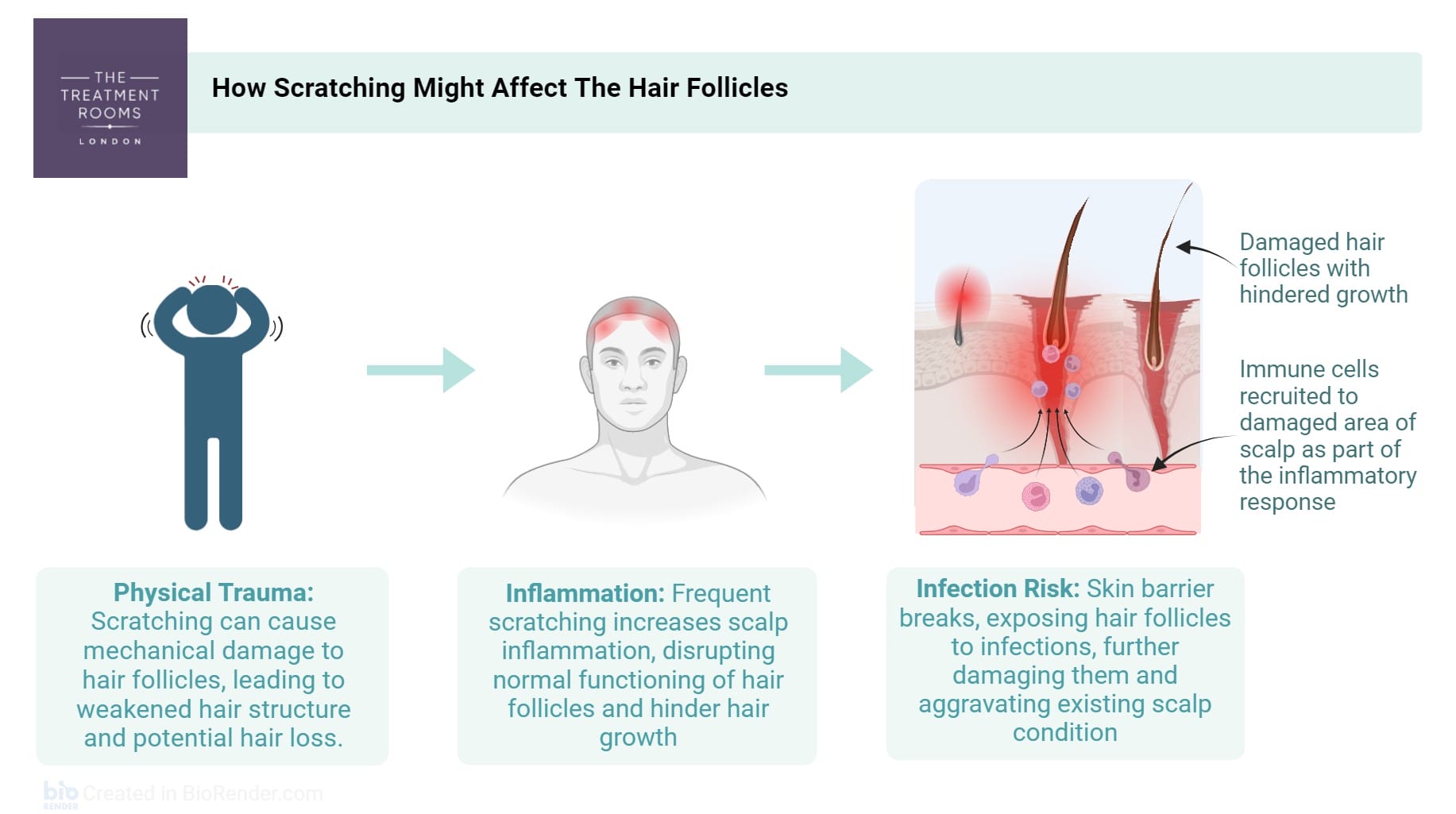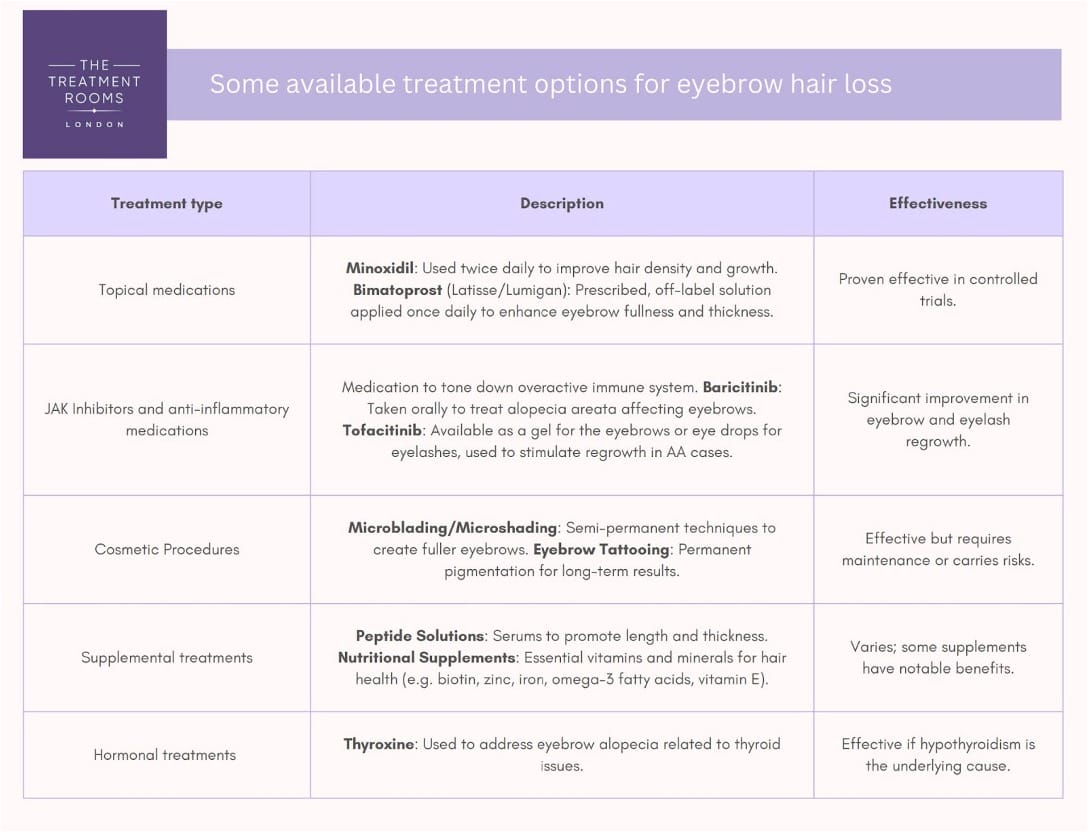Eyebrows are a subtle, defining feature of the face, framing it and helping us express our emotions. A Canadian study, found that eyebrows were more important than our eyes when making a lasting impression.1
However, just like the hair on our heads, eyebrows can also be vulnerable to thinning and hair loss, leading to self-confidence issues.2
When this happens, understanding the cause and treatments available is important so we can prevent the issue. This article highlights some of the main ways to identify eyebrow hair loss, delving into the diagnostic methods commonly used and the most effective treatment options available.
What causes eyebrow hair loss?
Eyebrow hair loss, or hypotrichosis, affects thousands of people yearly. According to the International Census of Hair Restoration Surgery, it is the most common type of non-scalp-based hair transplant in women.3
Eyebrow hair loss is characterised by thinning or development of irregular growth patterns in eyebrow hair. Some of the causes of eyebrow hair loss are summarised below.
Alopecia areata
Alopecia areata is an autoimmune disease that occurs when the immune system mistakenly attacks hair follicles causing hair loss.4
While the severity of alopecia areata varies from person to person, it typically affects the head and face, resulting in either random spots of hair loss or the total disappearance of all hair, known as alopecia universalis.4
It can also cause frontal fibrosing alopecia – a thin band of balding skin that runs along the front and sides of the hairline, mainly affecting people after menopause.5

Androgenetic alopecia
Also known as male or female pattern baldness, androgenetic alopecia is a genetically predetermined disorder that causes hair loss due to an excessive response to androgens – specific hormones that contribute to growth and reproduction.6
Regularly associated with hair loss on the scalp, androgenetic alopecia can also extend to the eyebrows, leading to gradual thinning, patterned baldness and the appearance of bald spots within the brow.6
Nutrient deficiencies
The body requires various nutrients to grow hair properly, including vitamins A, B, C, D and E and iron. Therefore, it’s vital to maintain a healthy diet filled with fish, nuts, seeds and leafy vegetables to avoid or minimise eyebrow hair loss.
Research also shows that deficiencies in fatty acids like omega-3 and omega-6, biotin and zinc also contribute to hair loss.7,8
Skin conditions
Hair grows directly from follicles in the skin. So, certain skin conditions can cause itchy, flaking skin that leads to rashes and inflammation in and around the eyebrow area. These typically include the following:7
- Atopic dermatitis – otherwise known as eczema. Skin inflammation, itching and irritation characterise this condition. Over time, it can impact the hair follicles’ strength and structural integrity, disrupting proper hair growth.
- Contact dermatitis – caused by exposure to allergens or irritants; this condition also results in itching and inflammation near the eyebrows, inhibiting hair growth and contributing towards hair loss.
- Psoriasis – an autoimmune disorder; psoriasis stimulates rapid skin cell multiplication, forming thick, scaly patches that can block hair follicles and prevent eyebrow hair growth.

Hormonal imbalances
Eyebrow hair loss is often associated with the thyroid diseases hyperthyroidism and hypothyroidism, which disrupt hormone production.
Having too much thyroid hormone (hyperthyroidism) and not having enough (hypothyroidism) can affect various bodily functions, leading to symptoms like dry skin, swelling in the neck, brittle hair and an itchy scalp.7 Over time, this can affect your eyebrows, too, leading to hair loss.
In addition, hormonal imbalances experienced during pregnancy and childbirth can also disrupt hair growth cycles, leading to temporary hair loss in various areas, including the eyebrows.
Ageing
As we age, it’s normal to experience hair thinning or loss that affects the head, eyebrows, eyelashes or other areas of your body.
Over time, certain hair follicles will stop growing in the same way, leading to a change of colour and the hair shafts (the visible part of the hair that sticks out of the skin) becoming finer.
Overplucking and poor grooming
Your beauty routine could also contribute to your eyebrow hair loss. Over-plucking your eyebrows or using harsh make-up products over a prolonged period can clog your hair follicles, leading to a lack of hair growth in certain spots. So, removing your make-up before you go to bed is vital.
Your skin and hair follicles undergo intense regeneration as you sleep. However, they cannot breathe and regenerate when make-up clogs the surrounding pores.
Chemotherapy and radiotherapy
Cancer treatments like chemotherapy and radiotherapy target rapidly dividing cells, which can include hair follicles. As a result, patients undergoing these forms of treatment may experience significant hair loss all over their body, including the eyebrows.
How is eyebrow hair loss treated?
Understanding the many reasons eyebrow hair loss can occur is crucial to accurately and effectively diagnosing it. Therefore, if you’re experiencing eyebrow hair loss and are unsure why, it’s vital to consult a healthcare professional.
They can discuss your medical history with you and identify the root cause before putting you on the most suitable and relevant treatment plan for your circumstances.
Some of the treatment options typically offered for eyebrow hair loss include:
- Minoxidil – this over-the-counter topical medication is approved for androgenetic alopecia. Research shows it can promote hair regrowth and density.9
- Corticosteroids – these anti-inflammatory and immunosuppressant medications come in topical, injectable or pill form and are regularly used to treat conditions like alopecia areata, atopic dermatitis and psoriasis.
- Anthralin – a topical treatment in the form of a cream, anthralin is typically used to treat skin conditions like psoriasis but is also an effective therapeutic option for severe alopecia areata.
- Bimatoprost (Latisse) – while more commonly used to treat eye conditions like glaucoma, research shows this ophthalmological medication also encourages eyebrow hair growth.10
- Follicular unit excision (FUE) eyebrow hair transplant – this safe, minimally-invasive procedure involves extracting donor hair follicles from the scalp before delicately transplanting them into tiny incisions the surgeon made around the eyebrow.11 The procedure can permanently restore hair in the eyebrows which you can read about here- is an eyebrow hair transplant permanent. Both women and men can undergo the procedure. An eyebrow hair transplant cost varies between £3,000-£5,000.

How effective are natural remedies for eyebrow hair loss?
Despite little evidence to prove their effectiveness, many patients try natural remedies before resorting to medication.
Some say acupuncture relieves alopecia areata by stimulating blood flow to the eyebrows, reducing the number of attacks on hair follicles and, therefore, making them healthier.12
People often believe castor oil is an effective eyebrow hair loss treatment as it contains certain properties that stimulate hormone production. However, limited and inconsistent scientific evidence is available to support these claims.12
So, while natural remedies may offer certain benefits, treatment options like Minoxidil and an FUE eyebrow hair transplant are clinically proven to restore hair loss and have various psychological benefits, such as improved self-confidence.2
The Treatment Rooms London: an eyebrow hair loss specialist
Our team at The Treatment Rooms London can help if you are concerned about eyebrow hair loss.
Our specialist surgeons have the skills and training to perform eyebrow hair transplants on anyone whose eyebrows are missing or thinning.
Using the FUE technique, we can rebuild thin or damaged eyebrows and even create natural-looking eyebrows for people with no eyebrow hair. The procedure can also be performed using the unshaven hair transplant technique– allowing you to go back to work and social life quicker after surgery.
Book a consultation with us to start this process or receive tailored advice on minimising your eyebrow hair loss. As the winner of the hair restoration clinic of the year for 2023, we are experts in eyebrow hair loss and would be happy to answer your questions.
Sources
- Sadr, J., Jarudi, I. & Sinha, P. (2003) The role of eyebrows in face recognition. Perception. Available at: https://pubmed.ncbi.nlm.nih.gov/12729380/ [Accessed 7 December 2023]
- Dhami, L. (2021) Psychology of Hair Loss Patients and Importance of Counseling. Indian J Plast Surg. 54(4): 411 – 415. Available at: https://www.ncbi.nlm.nih.gov/pmc/articles/PMC8719979/ [Accessed 7 December 2023]
- Relevant Research, Inc. (2020) International Society of Hair Restoration Surgery: 2020 Practice Census Results. International Society of Hair Restoration Surgery. Available at: https://ishrs.org/wp-content/uploads/2020/05/Report-2020-ISHRS-Practice-Census-05-22-20.pdf [Accessed 7 December2023]
- National Institute of Arthritis and Musculoskeletal and Skin Diseases (2021) Alopecia Areata. NIH. Available at: https://www.niams.nih.gov/health-topics/alopecia-areata [Accessed 7 December 2023]
- Ludmann, P. (2022) Hair Loss Types: Frontal Fibrosing Alopecia Overview. American Academy of Dermatology Association. Available at: https://www.aad.org/public/diseases/hair-loss/types/frontal-fibrosing-alopecia [Accessed 7 December 2023]
- Ho, C., Sood, T. & Zito, P. (2022) Androgenetic Alopecia. [Updated 2022 Oct 16]. In: StatPearls [Internet]. Treasure Island (FL): StatPearls Publishing; 2023 Jan-. Available at: https://www.ncbi.nlm.nih.gov/books/NBK430924/ [Accessed 8 December 2023]
- Stinson, A. & Cobb, C. (2023) What to know about eyebrow hair loss. MedicalNewsToday. Available at: https://www.medicalnewstoday.com/articles/325416 [Accessed 8 December 2023]
- Patel, D., Swink, S. & Castelo-Soccio, L. (2017) A Review of the Use of Biotin for Hair Loss. Skin Appendage Disord. 3(3): 166 – 169. Available at: https://pubmed.ncbi.nlm.nih.gov/28879195/ [Accessed 7 December 2023]
- Suchonwanit, P., Thammarucha, S. & Leerunyakul, K. (2019) Minoxidil and its use in hair disorders: a review. Drug Des Devel Ther. 13: 2777 – 2786. Available at: https://www.ncbi.nlm.nih.gov/pmc/articles/PMC6691938/ [Accessed 7 December 2023]
- Carruthers, J., Beer, K., Carruthers, A., et al. (2016) Bimatoprost 0.03% for the Treatment of Eyebrow Hypotrichosis. Dermatol Surg. 42(5): 608 – 617. Available at: https://www.ncbi.nlm.nih.gov/pmc/articles/PMC5414776/ [Accessed 8 December 2023]
- Vara, R. & Fernando, D. (2023) Eyebrow Hair Transplant Surgery. The Treatment Rooms London. Available at: https://www.treatmentroomslondon.com/hair-transplant-surgery/eyebrow-transplant/ [Accessed 8 December 2023]
- Leavitt, J. & Cobb, C. (2023) What’s Causing My Eyebrow Hair Loss, and How Can I Treat It? Healthline. Available at: https://www.healthline.com/health/eyebrow-hair-loss [Accessed 8 December 2023]
Share:
Authored by
Reviewed by
Book a Consultation
Related Blogs
Stephen Miller’ Hair Spray Gone Bad: Our Expert Coments and Insights
April 24, 2025
When Stephen Miller appeared on “Face the Nation”, his hairspray cover-up would later set social media on…
Ariana Grande Hair Loss: Prevention, Styling Secrets, and Hypothetical Transplant Solutions
April 10, 2025
Ariana Grande, the global pop sensation renowned for her signature high ponytail and bold hairstyles, has openly…
Daniel Craig Hair Transplant: Before, After and His Hairline
April 10, 2025
Daniel Craig, the world-famous English actor who gained international fame as the fast-paced, debonair James Bond, has…
Rob Brydon Hair Transplant: Before, After, and His New Hairline
April 8, 2025
Rob Brydon, the beloved Welsh comedian and Gavin & Stacey star, has traded his receding hairline for…
Gordon Ramsay Hair Transplant: Before, After, and His New Hairline
April 3, 2025
Gordon Ramsay, the fiery Michelin-starred chef, restaurateur, and TV personality, has swapped his receding temples for a…
Has Perez Hilton had a hair transplant? All You Need to Know
April 2, 2025
Perez Hilton is a familiar face in the media. He is known for his work as a…
Ronnie Vint – Love Island Hair Transplant: Before, After, And His Hairline
March 31, 2025
Ronnie Vint, a former footballer and current TV personality, appeared on the 2024 season of “Love Island”…
Prince Harry Hair Loss: Speculations, Treatments, and Possible Transplant Options
March 28, 2025
Prince Harry, the Duke of Sussex and beloved royal-turned-global humanitarian, has sparked global curiosity over his ever-evolving…
Elton John and His Hair Transplant Journey
March 27, 2025
Sir Elton John has had one of the greatest careers in music. Since his rise to fame…











